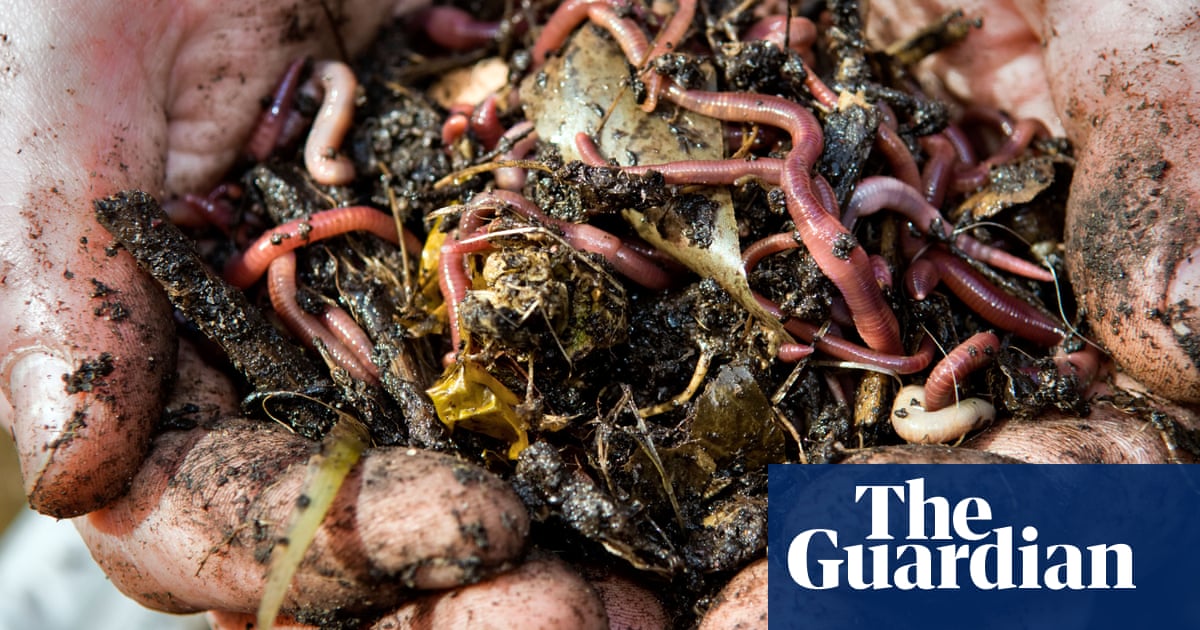In 2019, 15,000 children from primary schools across the UK went out to their local playing field. Instead of kicking a ball around, they dug up worms, looked out for birds, and counted them both.
âThe kids were just so enthusiastic about it. It was incredible,â said Blaise Martay, lead researcher from the British Trust for Ornithology (BTO). Martay had worried about the data quality â she thought childrenâs counting might vary with their enthusiasm. But the results âshowed exactly what weâd expectâ, she said: that more worms meant a greater number of blackbirds, robins and thrushes, the birds that rely on earthworms as a vital part of their diets. The data was consistent across school groups.
Earthworms are a keystone species with potentially enormous effects on above-ground wildlife and ecosystem functioning, yet we still know little about them. They live in a hidden landscape below our feet, breaking down organic matter into the soil so it can be used by other soil organisms. As they wriggle around, they create miniature tunnels, so air and water can pass through, with some deep-burrowing worms able to dig tunnels up to 2 metres deep. Sometimes called the âpoor manâs tropical rainforestâ on account of its biodiversity, topsoil is the bedrock for human food systems, and is where 95% of the planetâs food is grown.
Charles Darwin was so obsessed with these extraordinary creatures that he wrote his last book about them, based on a lifetime of study and fascination, and told his son William that what he hoped his book would reveal was that âworms have much bigger souls than anyone would supposeâ. Darwin thought that âit may be doubted whether there are many other animals which have played so important a part in the history of the world, as have these lowly organised creaturesâ, and his book was a bestseller.
But the UKâs first national assessment, published in 2023, found that earthworm populations had declined by a third over the past 25 years. âSuch declines would likely have significant effects on soil health, ecosystem structure and function,â researchers wrote in a 2024 âhorizon scanâ identifying the biggest threats and possibilities for biodiversity, published in Trends in Ecology and Evolution.
Large-scale wildlife declines have been reported in oceans, freshwater, and on land, but what is happening under the soil is still relatively unknown. âWe know birds that feed on earthworms are declining so we were wondering what was happening with the worms,â said Dr Ailidh Barnes, a research ecologist from BTO who conducted the national assessment.
Her paper found earthworm populations in the UK are in long-term decline of up to 2% a year. It is possible that other countries with similar land-use patterns have had equally dramatic declines. The biggest declines seen in Barnesâs study were in broadleaf woodland ecosystems. âThat was the finding we were most surprised by,â said Barnes. It could be because the climate crisis is drying out the soil, or runoff from surrounding farmland.
It is possible that the loss of earthworms could already be affecting broader woodland ecology. On average there are 37% fewer woodland birds in British woods compared with 1970, with declines accelerating in the past five years. âThe loss of worms could be playing a bigger part than we realise,â said Barnes.
Healthy worm populations are crucial for entire ecosystems, not just birds. Earthworms are ecosystem engineers. As they burrow and feed underground, they break down organic matter, which is then passed along the conveyor belt to smaller organisms. Wormholes create porous structures for water and air to travel through. They play a crucial role in nutrient recycling and soil fertility, which means they significantly contribute to global food production.
âEarthworms are vital at looking after the soil, which is the basis of all life and what grows our food,â said Barnes.
If trends revealed by her study hold true elsewhere the loss could affect our ability to feed a growing human population. Wormsâ contribution to the worldâs grain harvest matches that of Russia, according to a 2023 study, which found they help make 140m tonnes of food a year. This would make them the fourth largest global producer if they were a country.
after newsletter promotion
Another paper from last year found more than half of the worldâs species live in the soil. Yet despite their importance in supporting ecosystems and providing food for humans, soil invertebrates have been âwoefully neglectedâ in biodiversity assessments. Extensive drainage, pesticide use and the use of inorganic fertilisers are likely to be driving them, but data on trends in population abundance are generally only available from studies covering small areas.
Barnes said: âThey are vital for everything. When you start talking to people about earthworms they are interested, but theyâre under the ground so they get forgotten about.â
-
Welcome to the Guardianâs UK invertebrate of the year competition. Every day between 2 April and 12 April weâll be profiling one of the incredible invertebrates that live in and around the UK. Let us know which invertebrates you think we should be including here. And at midnight on Friday 12 April, voting will open to decide which is our favourite invertebrate â for now â with the winner to be announced on Monday 15 April.
-
Find more age of extinction coverage here, and follow biodiversity reporters Phoebe Weston and Patrick Greenfield on X for all the latest news and features



